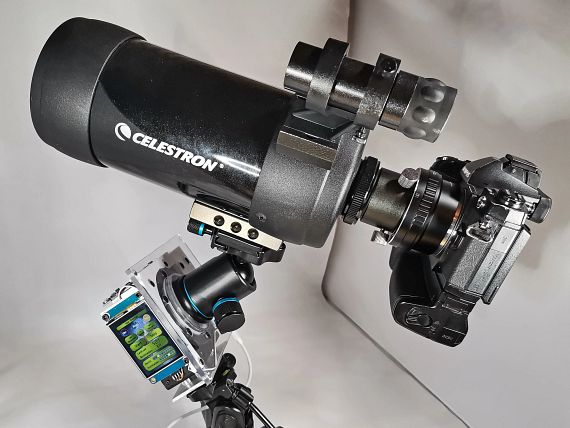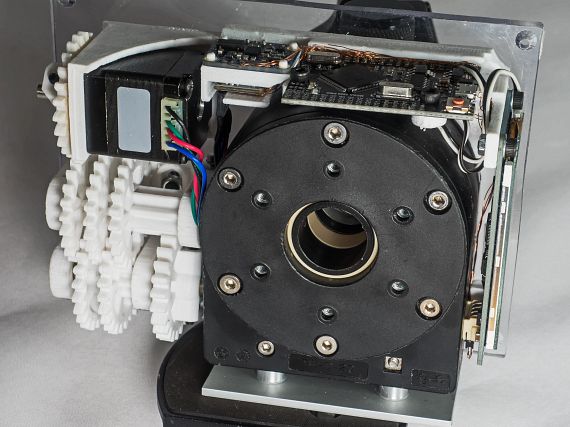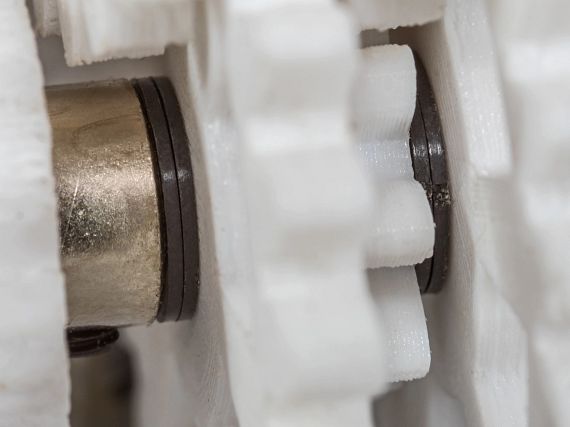3D printed cost-effective components for astrophotography
3D printed parts are ideal fror so many applications. They can be printed quickly, with no minimum order quantity and with igus®, in wear-resistant materials. An example of an application is shown below:
- What was needed: a gearbox that rotates a device with camera and lens 360° in 24 hours
- Manufacturing method: filament extrusion (FDM)
- Requirements: cost-effective, varied but precise rotation speeds, high device strength
- Material: iglidur I150
- Industry: astrophotography
- Success from the collaboration: high precision, strength, and abrasion resistance, low friction thanks to thrust washers
Contact an expert

The application at a glance:
In astrophotography, various celestial bodies are imaged by means of time exposure and stored on a suitable medium. Anyone who has ever changed the exposure time on his mobile phone or digital camera knows that photos taken with a long exposure time can be blurred by minimal changes. The Earth rotates around its axis, and this rotation is a problem for the long exposure times required in astrophotography. Mr van Hove of vhw Digitalart has developed a device that compensates for the Earth's rotation in order to image celestial bodies in their real form. The requirements for the plastic gearbox were a rotation of 360 degrees in exactly 24 hours, enough load capacity to support the camera and its lens, and high individual component stability and abrasion resistance. The gearbox also needed to set different speeds depending on the celestial body to be tracked. The gearbox and all brackets for the motor and electronics were 3D printed from the iglidur i150 tribofilament. In addition to the cost advantage of the 3D printed components, the igus high-performance plastic's high abrasion resistance and suitability for rotational and pivoting applications also played a major role in the selection of material and manufacturing process.
In astrophotography, various celestial bodies are imaged by means of time exposure and stored on a suitable medium. Anyone who has ever changed the exposure time on his mobile phone or digital camera knows that photos taken with a long exposure time can be blurred by minimal changes. The Earth rotates around its axis, and this rotation is a problem for the long exposure times required in astrophotography. Mr van Hove of vhw Digitalart has developed a device that compensates for the Earth's rotation in order to image celestial bodies in their real form. The requirements for the plastic gearbox were a rotation of 360 degrees in exactly 24 hours, enough load capacity to support the camera and its lens, and high individual component stability and abrasion resistance. The gearbox also needed to set different speeds depending on the celestial body to be tracked. The gearbox and all brackets for the motor and electronics were 3D printed from the iglidur i150 tribofilament. In addition to the cost advantage of the 3D printed components, the igus high-performance plastic's high abrasion resistance and suitability for rotational and pivoting applications also played a major role in the selection of material and manufacturing process.

Problem
The Earth's rotation must be compensated for so that long exposures can be made over several hours. The device that ensures that the celestial body to be imaged does not move from the camera's perspective and must move it and the lens or telescope so that it is stable. This includes precise and even rotation. A controller and an externally mounted control panel must also set different rotation speeds as the tracking times vary by object.Solution
Mr van Hove found the right materials for his project in close cooperation with igus. The RL-D-20 pivot bearing with its gear reduction of 1:38 ensures load capacity and precision. The high strength and abrasion resistance of the 3D printed gears and brackets is achieved with the iglidur i150 tribologically optimised filament. This material is particularly well suited to applications with low sliding speeds. The gearbox has a gear reduction of 1:243. The 3D printed gears' friction is reduced and loss-free rotation achieved with two thrust washers between the components. Mr van Hove says that the cooperation was "very good, as usual".How does astrophotography work?
In astrophotography, celestial bodies, nebulae and other objects in the night sky are imaged in visible light and stored on various media. The camera is oriented on the geographic North Pole parallel to the Earth's axis. The inclination of the camera corresponds to the latitude. The exposure time for such photographs is several hours, which is why the camera must be adapted to the Earth's daily rotation. Otherwise only lines will be visible instead of the objects' actual shapes. An appropriate device, a tracker compensates for the Earth's rotation if the rotation speed corresponds exactly to one revolution per day. There are also different rotation speeds depending on the object to be tracked. For stars, one revolution takes 23 hours, 56 minutes and 4 seconds. The moon requires a revolution time of 24 hours, 52 minutes and 28 seconds, while the sun requires exactly 24 hours.High precision despite high payload
The device must be able to support the entire weight of the camera and lens or the telescope throughout 360° rotation over 24 hours . Depending on the size, model, and equipment, this can be up to 4kg. The high precision of the rotation is achieved with a pivot bearing with a gear reduction of 1:38. A mechanical service life of at least 1,000,000 cycles also guarantees a long service life for the overall system. The 3D printed gear with a reduction ratio of 1:243 enhances strength and also has a long service life. This is due to the thrust washers used and also the abrasion-resistant iglidur® I150 plastic.
Further information about igus gearboxes

iglidur® I150 - a tribofilament with many strengths
The tribologically optimized iglidur® I150 filament is easy to process and suitable for all 3D printers in the FDM process. In addition to the high abrasion resistance at low glide speeds and good mechanical properties of the high-performance polymer, iglidur® I150 is also suitable for contact with food products according to EU Regulation 10/2011. The integrated solid lubricants ensures it is maintenance-free and most applications benefit from its strength and layer adhesion.
More about iglidur® I150

More about the igus products used
Other application examples for 3D printed components can be found here:
All customer applications at a glance